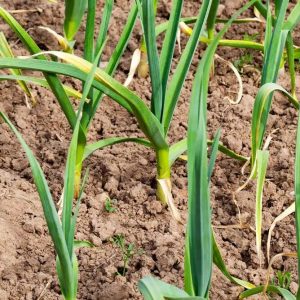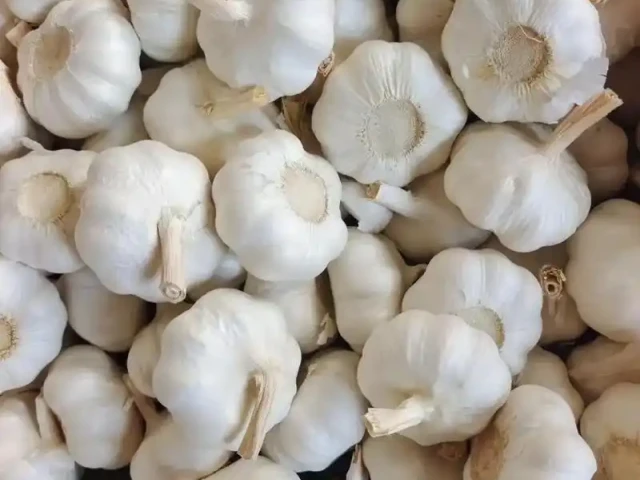The planting method of garlic is as follows:
1. Planting time
Garlic is generally sown in autumn, and the specific time varies depending on the climate of the region. It is usually more suitable to sow between late September and mid-October.
2. Seed selection
Choose full, pest-free, and undamaged garlic cloves as seeds.
You can choose excellent varieties suitable for local climate and soil conditions, such as purple garlic, white garlic, etc.
3. Land preparation and fertilization
Choose fertile and well-drained soil plots.
Deeply turn the soil, the depth is generally about 20-30 cm, so that the soil is loose and breathable.
For base fertilizer, you can choose decomposed organic fertilizers, such as manure, compost, etc., the application amount per mu is 2000-3000 kg, and an appropriate amount of compound fertilizer can be added to provide the nutrients needed for garlic growth.
4. Sowing
Ditching: Dig trenches on the prepared land, the trench depth is about 3-5 cm, and the trench distance is generally 15-20 cm.
Sowing: Insert the garlic cloves into the ditch, with the tip of the clove facing up and the root facing down, and then cover with soil. The thickness of the soil is about 2-3 cm.
Watering: Water thoroughly after sowing to keep the soil moist.
5. Field management
Management during the germination period: Generally, the seedlings will emerge about 7-10 days after sowing. Check in time after germination. If there are any seedlings missing, replant them in time.
Watering and fertilizing:
During the growth of garlic, water should be applied in time according to the soil moisture conditions to keep the soil moist, but not waterlogged.
At different stages of garlic growth, fertilization should be applied reasonably. Generally, about 15-20 days after garlic sprouts, a seedling fertilizer can be applied once, mainly nitrogen fertilizer; before garlic overwintering, a winter fertilizer can be applied once in combination with watering; after garlic turns green, a green fertilizer can be applied once; during the garlic stalk extension period and garlic bulb expansion period, fertilization should be applied again, mainly phosphorus and potassium fertilizers, with appropriate amount of nitrogen fertilizer.
Intertillage and weeding: During the growth of garlic, intertillage and weeding should be carried out in time to keep the soil loose and prevent weeds from competing with garlic for nutrients.
Pest and disease control: Common pests and diseases of garlic include leaf blight, rust, garlic maggots, etc. According to the occurrence of pests and diseases, corresponding prevention and control measures should be taken in time, such as spraying pesticides, biological control, etc.

Garlic stalk harvesting: When the top of the garlic stalk is bent and the involucre turns white, the garlic stalk can be harvested. Generally, the garlic stalk is harvested about 20-30 days after it is pulled out.
Garlic bulb harvesting: About 20-30 days after the garlic stalk is harvested, when most of the garlic leaves are yellow and the pseudostem becomes soft, the garlic bulb can be harvested. After harvesting, it should be dried in time to prevent the garlic from mold and deterioration.
What is the amount of fertilizer applied to garlic at different growth stages?
The amount of fertilizer applied to garlic at different growth stages is as follows:
1. Seedling stage
Generally, no additional fertilizer is required. During this stage, the basal fertilizer applied before sowing is mainly used to meet the needs of seed germination and emergence. If the soil fertility is particularly poor, a small amount of dilute nitrogen fertilizer solution can be appropriately applied after emergence, such as 3 to 5 kg of urea per mu mixed with water to promote seedling growth.
2. Seedling stage
Seedling fertilizer: Apply seedling fertilizer about 15-20 days after garlic emerges. Nitrogen fertilizer is the main fertilizer, such as 10-15 kg of urea or 20-30 kg of ammonium bicarbonate per mu. At the same time, an appropriate amount of phosphorus and potassium fertilizer can be applied, such as 10-15 kg of superphosphate and 5-8 kg of potassium sulfate per mu.
If the seedlings grow weakly, a small amount of nitrogen fertilizer can be applied again after an interval of 15-20 days, and 5-8 kg of urea per mu can be used.
3. Wintering period
Before wintering, wintering fertilizer can be applied once in combination with watering to enhance the cold resistance of garlic. Generally, 1000-1500 kg of decomposed organic fertilizer or 15-20 kg of compound fertilizer is applied per mu.
4. Greening period
After the spring greening, timely topdressing of greening fertilizer is applied. 15-20 kg of urea and 8-10 kg of potassium sulfate can be applied per mu.
High-nitrogen and high-potassium compound fertilizer can also be applied, with a dosage of 20-25 kg per mu.
5. Garlic stalk extension period
During this stage, the fertilizer requirement is large, and it is necessary to apply fertilizer again. 25-30 kg of compound fertilizer, or 15-20 kg of urea, 10-15 kg of potassium sulfate, and 15-20 kg of superphosphate can be applied per mu.
At the same time, you can combine foliar spraying with 0.2% – 0.3% potassium dihydrogen phosphate solution and 0.1% borax solution, spray once every 7 – 10 days, and spray 2 – 3 times continuously to promote the growth of garlic stalks.
6. Garlic expansion period
The garlic expansion period is a critical period that determines the yield and quality of garlic, and the fertilizer requirement is also large. 20 – 25 kg of high-potassium compound fertilizer, or 15 – 20 kg of potassium sulfate, and 5 – 10 kg of urea can be applied per mu.
Foliar spraying can also be carried out, such as spraying 0.3% – 0.5% potassium dihydrogen phosphate solution, spray once every 7 – 10 days, and spray 2 – 3 times continuously to promote the expansion of garlic.




